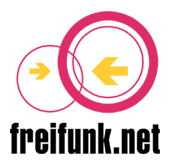
For more than 15 years I was an active member of the Freifunk Community. Since its foundation back in 2003 it was a long and exciting journey for me. In this article I want to share some of my very personal highlights and thoughts on this trip.
The Power of Endurance
Starting from scratch in Berlin back in 2003, in 2017 the German Freifunk community had more than 400 associated chapters all over the country. And the many, many volunteers engaged – aka the Freifunkas – where operating over forty-thousand access points with a Freifunk firmware. But the final break through took us over a decade and required a lot of engagement and endurance.
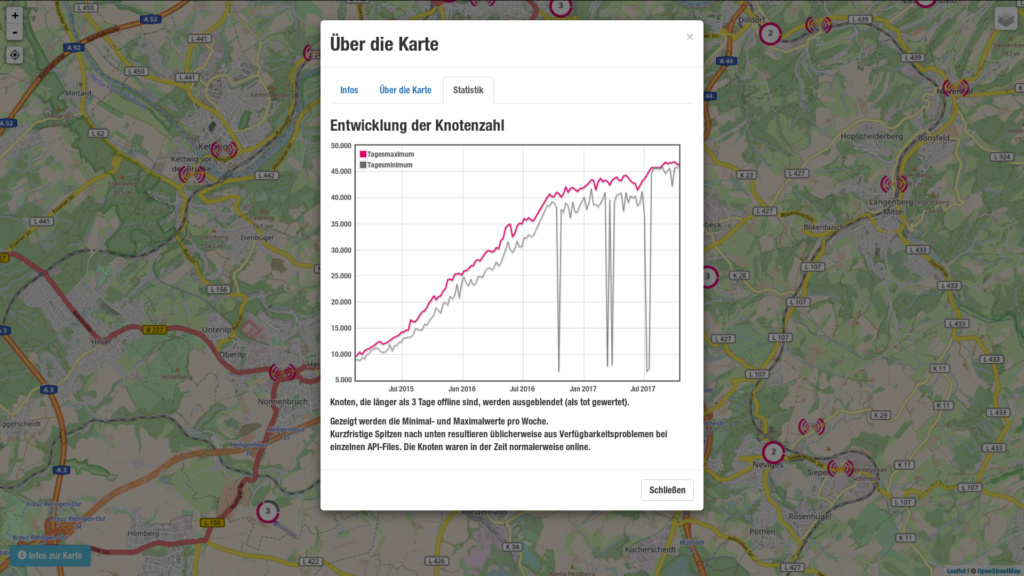
A personal light bulb moment to actually grasp that incredible development happened to me when I was visiting my mother’s family in a very small village in the West of Germany, close to the Belgium border. Taking a walk I realized someone had installed two Freifunk nodes in the street where I used to play as a child. So what a handful of people had started in Germany’s very East about a decade ago has made it all across the country. It reached out to someone whom I did not know at all in that very remote place where I used to spent most of my holidays when growing up. It was real and it was touching.
Art Is The Governor Of Utopia. (Max Frisch)
Not only do I think that some of the software developers and thinkers who have been engaged in developing of the Freifunk Firmware and new meshing algorithms are real artists. I also think that designers and internet experts like Monic Meisel were definitely key to the success. She created the Freifunk “Brand” and gave it its unique “Community Identity” (CI).
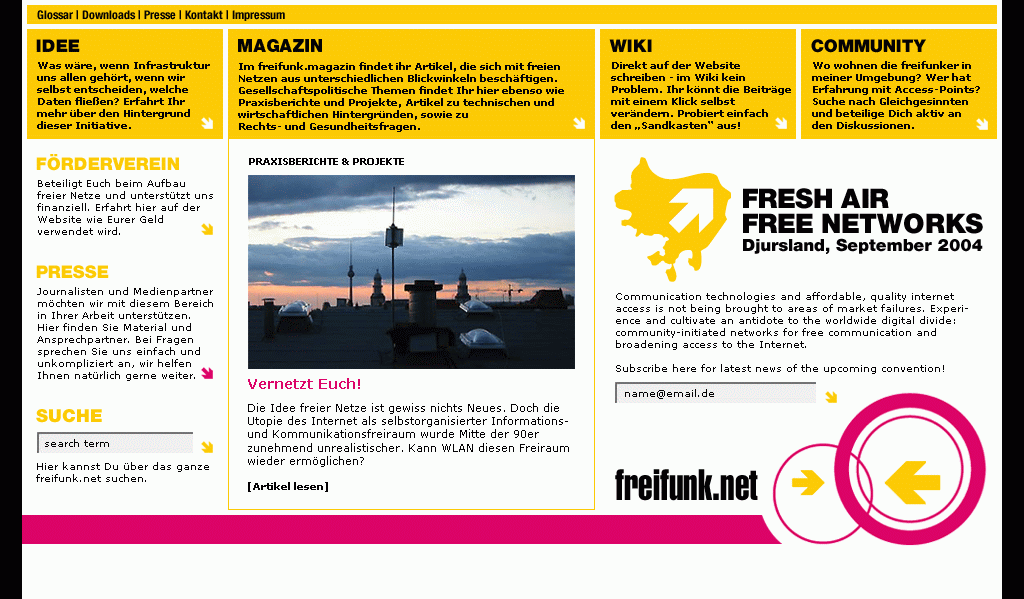
When Freifunk started there were already a bunch of wireless networks out there in Berlin and in other parts of Germany. Many of them were facing similar problems, both on a legal an on a technical level. But back in the days it was not so easy to try to join forces. I remember these times being very much dominated by quite a competitive atmosphere and clearly showing a lack of solidarity. Instead of working together and sharing their knowledge many of these WiFi experts preferred to be the local heroes.
So with Freifunk we had to add something to the situation that would be of benefit to all the local activities and activists. At the same time we did not want to become a hierarchical organization. That finally gave birth to the idea of a “Community Franchise Model”. We created a brand with a logo, we created a website, stickers and presentation templates. We featured the local communities on our website, translated English articles to German and organized the first community events, inviting everyone to join. We offered the local communities a free subdomain – e.g. berlin.freifunk.net – and we even invited them to modify the logo and the presentation templates to their needs and flavors. Slowly but surely more and more regional projects joined the “franchise” and adopted to the shared brand of Freifunk.
But with the growing success came the growing confusion. People had different ideas about Freifunk. To some of them Freifunk just meant to deploy any kind of wireless infrastructure that offers access to the internet. Others even wanted to turn it into a business. Some of those individuals tried to take over and to dominate the concept with their own ideas, while the majority of the community – including me – had a clear notion of being non-commercial, community owned, based on free software, sharing our knowledge and reducing or avoiding hierarchies – both on a technical and social level – where ever possible.
While one way to deal with these conflicts were long threads on mailing lists, another approach was to produce a small video clip to spread the message. It was the Berlin based video artist Philipp Seefeldt who helped us pro bono to create that clip. And with Anne Helm we found another supportive artist who gave her well known voice to Lisa, the character explaining the concept and its foundation – our utopia.
Support From The Local Regulator
With a “Meta Community Project” like Freifunk it is totally clear for me that one cannot boil down the success of it to a certain constellation of individuals or actions, especially since I am aware that I do not even know all of the players in person. And in the end each single actor in the puzzle is definitely somehow part of the success.
But from my very personal perspective there is one man who opened an incredible important gate for Freifunk and who definitely impressed me with his actions. I am talking about Hans Hege, the former director of the state media authority Medienanstalt Berlin Brandenburg (mabb).
When he learned about Freifunk it was no question to him to support us. By that time we were still struggling a lot from the unclear legal situation about secondary liability issues. Our workaround was to tunnel the traffic via Internet Service Providers. ISPs by law were not held responsible for their users’ actions. So we somehow fixed the problem. But still for the majority of the people we had the image of doing something illegal. And while a hand full of christian communities in Berlin had given us access to their church towers early on, it remained very difficult to win other institutions over.
Hans Hege was not the kind of person to support us the way he thought it would be best for us, but he was one of the very few individuals in such a position who really listened. He wanted to learn more about our problems and he accepted to work with us under our rules and conditions as a community where possible. In the process of getting to know each other he and his team joined our regular meeting at the c-base – a local hackerspace.
We agreed on a funding for material expenses to improve and expand our wireless infrastructure for the BerlinBackBone. Hege also tasked us with the installation of a new node for the BerlinBackBone on the rooftop of his office building. In addition he and his team published a nicely illustrated flyer and the brochure “WLAN FÜR ALLE” (English: “WiFi for all”) about Freifunk and likewise community wireless networks. This was definitely the accolade!
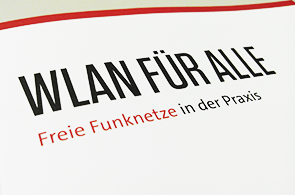
The brochure gave a profound introduction to the goals of Freifunk and well explained the validity of our legal work-around to tunnel our internet traffic via registered Internet Service Providers and to bypass secondary liability issues this way. Hege also successfully spread the idea of supporting Freifunk Initiatives amongst his colleagues – the directors from other state media authorities in Germany. So with the regulator promoting Freifunk, it became very difficult for others to argue against it. With all his actions he gave us an enormous back-up and a high-level credibility.
When the Court of Audit later asked him for an explanation for supporting Freifunk he replied: “Since its foundation, one of the tasks of mabb has been to support open channels for media and communication and also to open up opportunities for non-commercial initiatives.” And that is exactly what he did.
Freifunk in the German Museum of Technology
When we were campaigning against secondary liability issues with the Freifunk Freedom Fighter Box we spent nights sitting in our basement re-flashing over one hundred routers and decorating them with nice stickers. The campaign became very successful and created a lot of publicity.
Around that time the German Museum of Technology decided to expand their area and to make extra space for a new permanent exhibition about ‘The Net’. A group of young curators was hired to design that new chapter, covering the technological development of the Internet and related topics. At some point they contacted us and asked for all kinds of artifacts, including many old access-points, antennas and the Freedom Fighter Box.
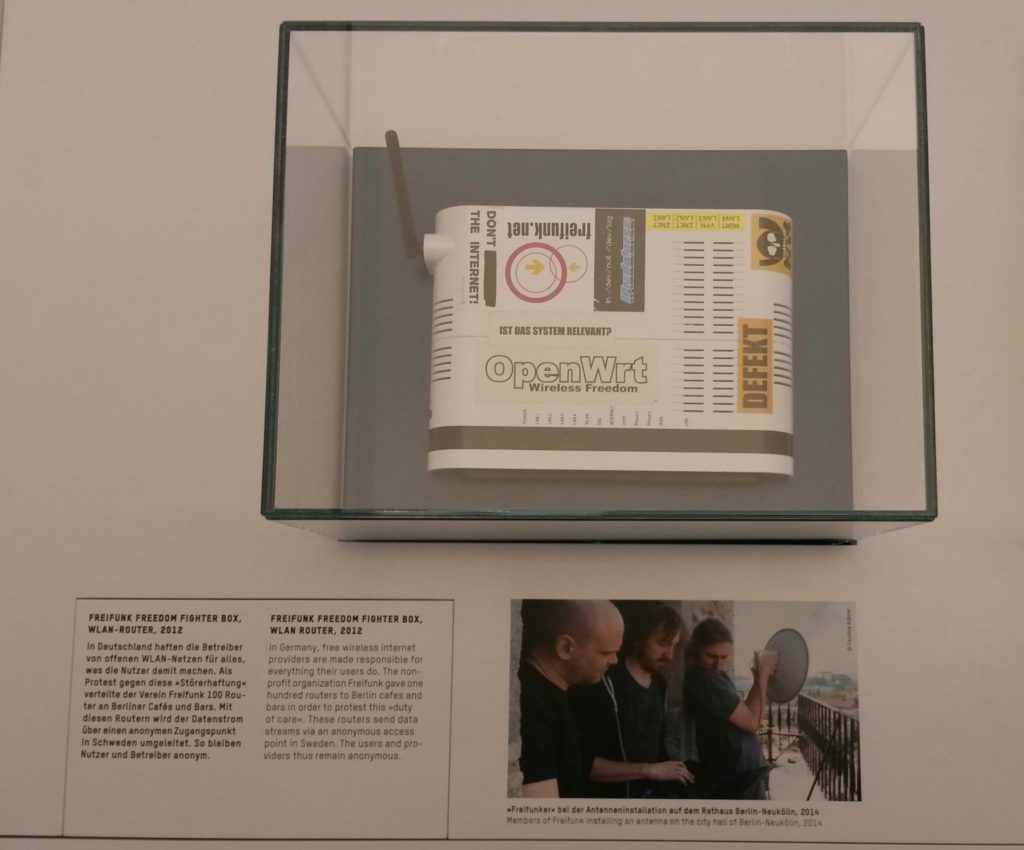
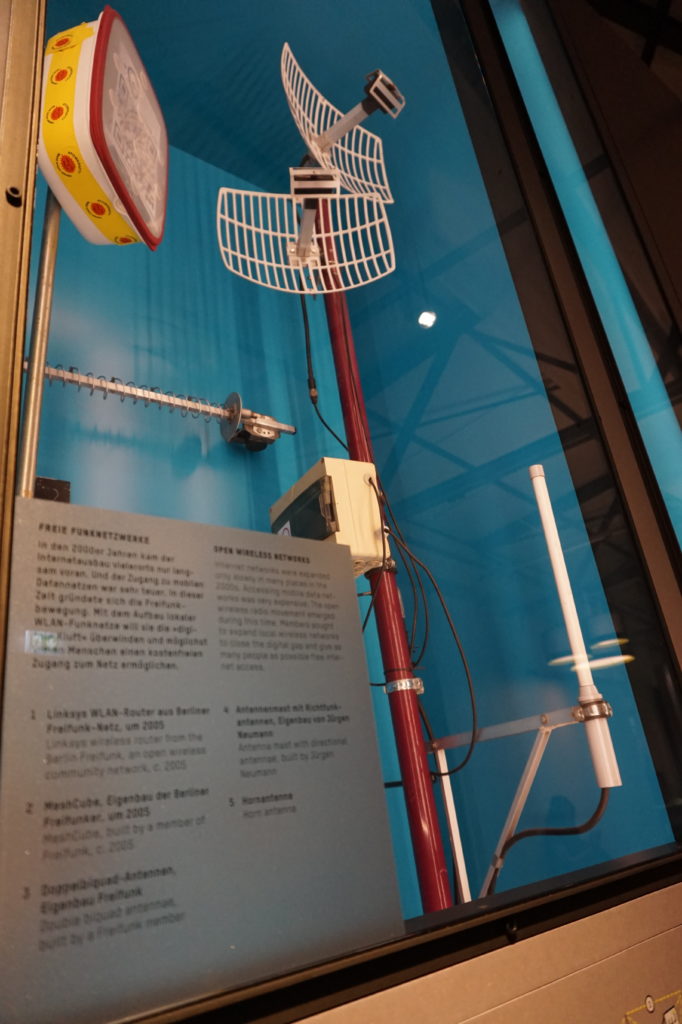
As we got in touch with the curators we also discussed to make the museum become part of Freifunk’s BerlinBackBone infrastructure and to offer free WiFi for their visitors. The administration was not easy to convince to put a Freifunk installation on top of their buildings and – even worse – to offer free WiFi inside the exhibition. That was mainly due to to the legal uncertainty of secondary liability issues. But after a longer process of ‘lobbying’ the director finally agreed. A real WOW! moment when the exhibition was officially opened to the public and we were witnessing that Freifunk made it into the National Museum. And shortly after the opening the museum won an innovation price for offering free WiFi to their visitors. 😉
Meshing Around The World
Back in 2002 Nicholas Negroponte explained why Wi-Fi “lily pads and frogs” will transform the future of telecom. For Freifunk the idea of meshing was the desired technological implementation of the social and political ideals of a community network from the very beginning. That’s why we provided a German translation of Negroponte’s article on the front page at the very first launch of our website. We definitely wanted to get rid of “master and slave” modes! But many “experts” were doubting they could scale beyond a few nodes.

The only information we found about mesh networks were some abstracts on military research projects and some very theoretical academic work here and there. We came across a few closed source versions of it, but that was useless for us. Until we stumbled over a first open source implementation of OLSR written by Andreas Tønnesen at the University of Oslo. We invited him to the c-base and the project took off.
Next we wanted and needed to put our own software on the routers to play with it. But at that time it was a very time-consuming process to re-engineer the WiFi hardware and to flash it with our own software. Thanks to the work of the OpenWRT community over time it became easier for us to play with the hardware and create our own firmwares. Finally our Freifunk Firmware was easy to configure, it looked cool and it could handle the growing number of nodes in the mesh networks. Our communities were growing and growing, and so were our mesh-networks.
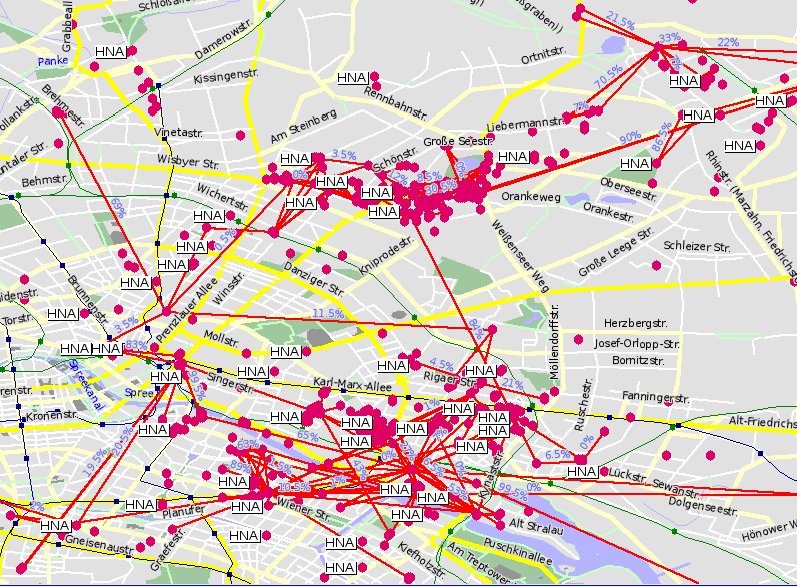
The word reached out to the world and made me and others from Freifunk participate in various conferences, workshops and get-togethers around the globe. In the earlier years most of them where self-organized. We met with people from other free network communities. These physical meetings at international level helped us to exchange our knowledge and experiences and to grow our social mesh and impact. And so did the Battlemesh – The Wireless Battle of the Mesh, an extra community event that aims at bringing together people from across the world to test the performance of different routing protocols for ad-hoc (mesh) networks.
In 2012 I got invited to the Harvard University to participate in “Public Networks for Public Safety: A Workshop on the Present and Future of Mesh Networks”. Obviously Community Networks and mesh networking became a serious matter in the academic world, and our progress and experience was feeding this process.
Nowadays meshing wireless access points have become a commodity. Most manufacturers offer several models with meshing technologies and do market special “community” routers that are easy to reflash with alternative firmwares. It feels really good having witnessed this process of community driven innovation from the very early experiments during the first “wavelöten” gatherings at Berlin’s c-base all the way down into off-the-shelf products over more than a decade later.
Collaboration Across All Borders
To my understanding the national and international success of community wireless networks was a result of individuals joining their forces across geographical borders, cultural borders, social borders or borders of education and expertise.
At the beginning for me it was just a handful of “geeks” from London and Berlin getting together at Bootlab in October 2002. But the early discussions about the Pico Peering Agreement and the people I met there were a personal mind opener on the political and international dimensions of the topic and the kick-starter of my engagement. I learned about the Danish farmers from Djurlands.net who by that time had build the largest wireless network in Europe. I learned about other existing projects in Europe, the USA, Africa, India and other parts of the world.
Together we realized that the need for communication and access to the Internet was a global issue. So over the years we organized several international meetings in various countries, a mixture of hackathon, party, DIY workshop and academic conference. At some point we started to call them World Summits for Free Information Infrastructures (WSFII).

These international gatherings also had a strong impact on the local movements where they took place. While all Community Wireless Networks were facing more less the same problems, their local reach-out and impact was often very limited. We were basically saying the same things, but because the grass is always greener on the other side, it attracted much more attention to hear it from a person from far, far away, rather than listening to the local activists.
So by organizing those conferences with international participants, the local politicians and media suddenly became much more interested and aware of the topic and their local actors. Luckily we showed more solidarity than competition in that situation and so we managed to help each other by “playing” the “international experts” for each other while having a good laugh about it. These conferences were fostering our international relations, also on a very personal level. Besides that, they attracted more and more people from academia to the topic.
Together with these scientists we managed to realize two EU Projects. The first one was the Confine-Project with focus on the technical implementation of community wireless networks. The second one was the netCommons Project, which focused more on the legal and social aspects. Some of the academics engaged were of incredible great support in terms of policy changes within the EU and in developing general recommendations to governments on international level for Community Wireless Networks at the World Social Forum. Another outcome of netCommons is this book: TELECOMMUNICATIONS RECLAIMED: A HANDS-ON GUIDE TO NETWORKING COMMUNITIES
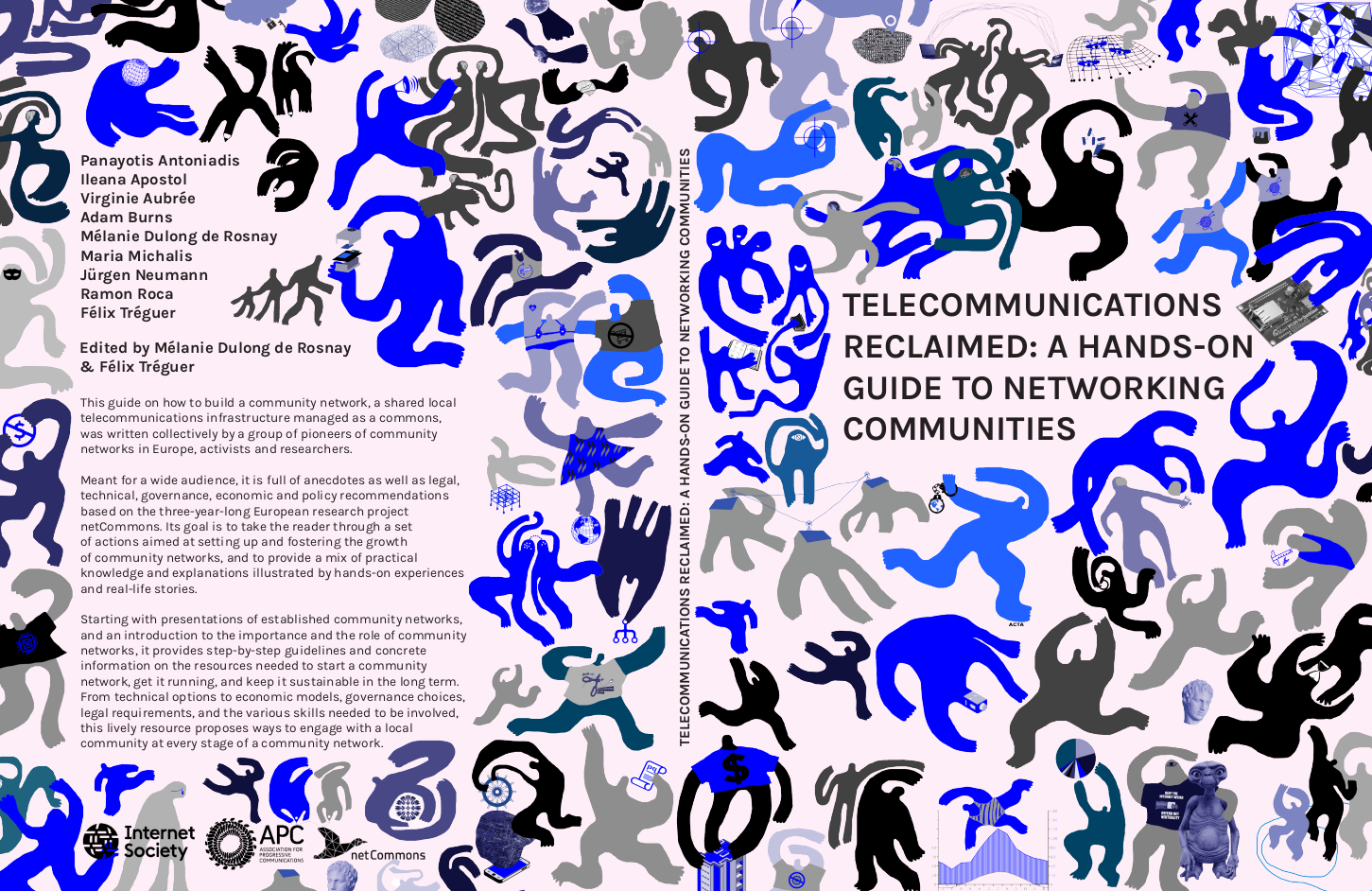
Changing The Law
Are you breaking the law by providing an anonymous, free and open access-point to the public? Should you be held responsible for illegal actions of other people who use your infrastructure? That secondary liability question (German: Störerhaftung) had always been very struggling to Freifunk. Well not only to Freifunk, but to anyone who wanted to offer free WiFi to the public. The German and European law was very uncertain about it and the courts were making different decisions here and there depending on their bias.
Most of mainstream media created an atmosphere of fear rather than to support the process of clarification. At the same time the telecom companies did not provide access to the internet in areas of market failure – like in my family’s little village – but instead they made a hell lot of money in the urban spaces, especially through mobile access and roaming fees.
In fact everyone was really happy to consume free WiFi – be it those who could not afford mobile communication in general or all the people traveling from abroad or people with little or no access to the internet. But providing it has always been seen as a risk that many people did not want to take. So early on we started the “Freifunk statt Angst!” campaign.
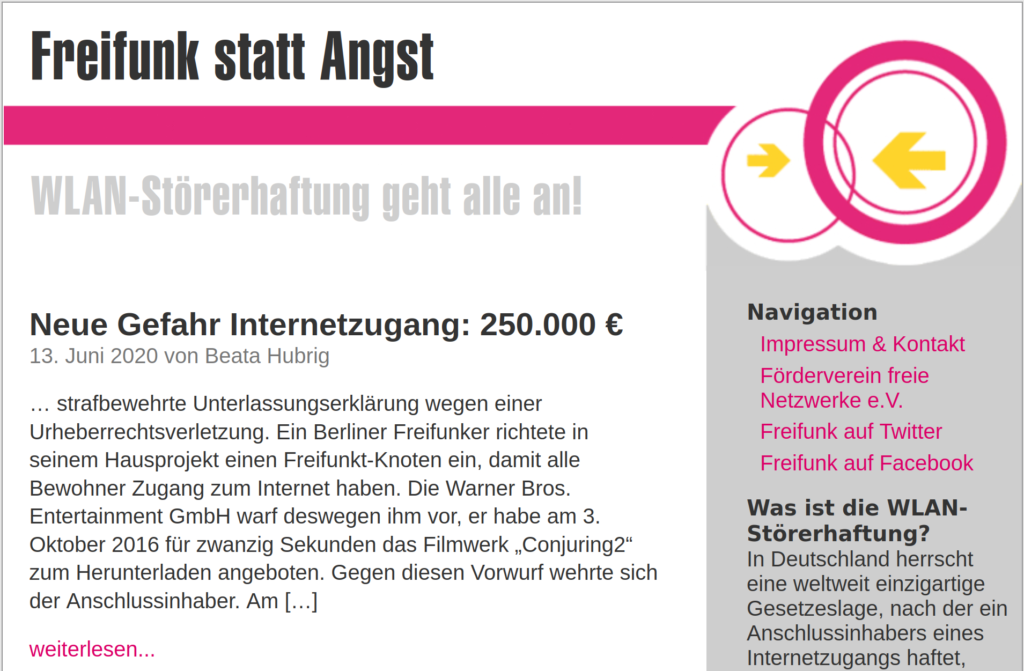
To me it has been very annoying how people’s idea of freedom and risk is deferring from many real world examples when it comes to digital media. As a society we do agree that the entity that provides a sidewalk is not held responsible for other people driving their e-scooters around on it. No one is forced to keep records of all the people who are using the sidewalk. But in the digital sphere people often tend to total observation and control. And while on a sidewalk people actually get hurt or even killed, most of the damage on the Internet is about financial loss of the content industry.
Luckily Freifunk activists and other like-minded combatants in Germany and Europe finally managed to make so much noise about it, that the law was changed in 2017. Störerhaftung adé!
Also after many years of struggling, by the end of 2020 Freifunk was finally included in the list of charitable not-for-profit activities by the Finance Committee of the German Bundestag, the National Parliament.
The Final Cut
I am very happy that Freifunk finally became such a great success. At the same time it became a very life filling volunteer work for me with only little space left for extra activities. During the last years of my engagement I realized that it became quite an exhausting trip on a personal level. I was tired of repeating myself in all the conversations, discussions and interviews. So in the end I decided to let go and to make space for other things to come.
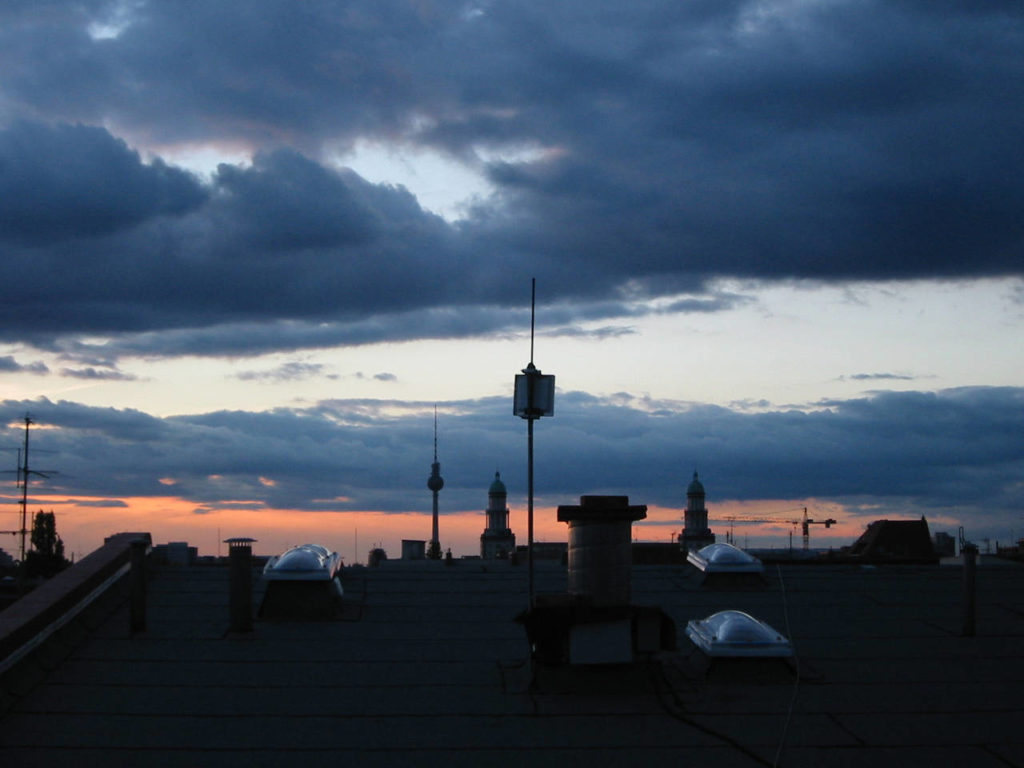
I feel privileged, glad and thankful for the many things I was able to learn and to experience on that journey. My special thanks go to the many known and unknown people who have all been part of the puzzle – especially to those who continue to build and to promote free communication infrastructures in Germany and all around the globe.
![]()